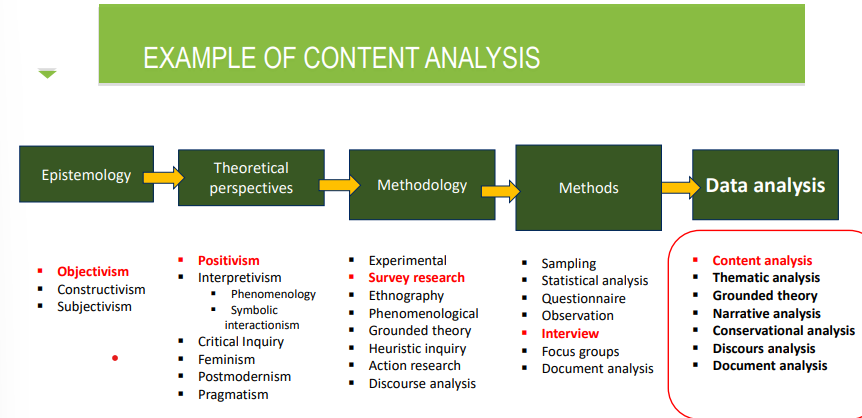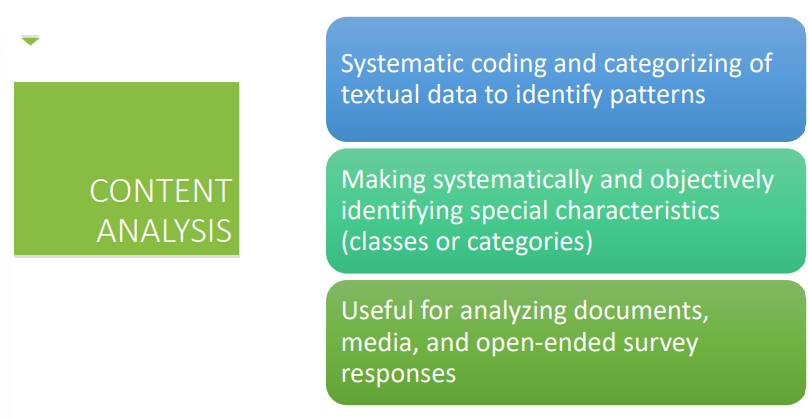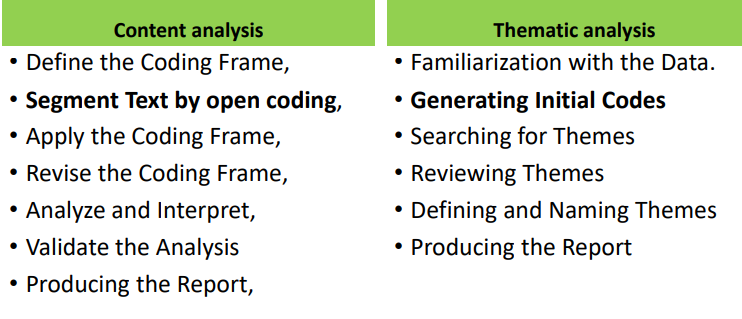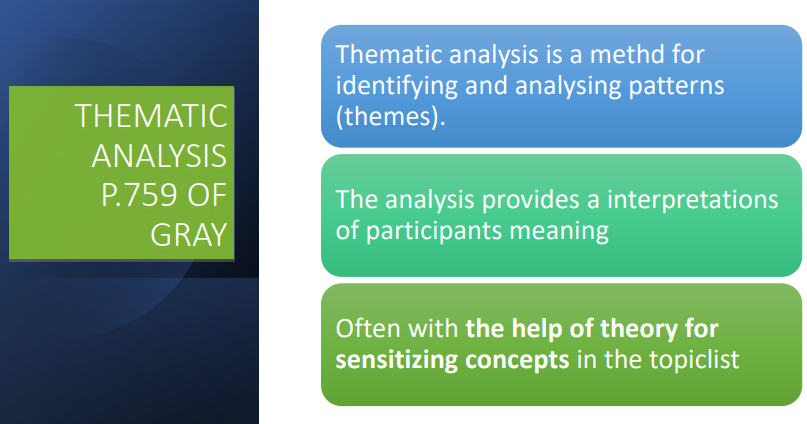RMHS - lecture 7 - analysing and presenting qualitative data
1/41
There's no tags or description
Looks like no tags are added yet.
Name | Mastery | Learn | Test | Matching | Spaced |
|---|
No study sessions yet.
42 Terms
ALSO LOOK AT THE SLIDES FROM THE LECTURE FROM 26/9
ESPECIALLY FOR EXPLANATION DEDUCTIVE VS INDUCTIVE
ALL THE TERMS
THE 6 DIFFERENT STEPS
THE 3 DIFFERENT STEPS (OPEN CODING, AXIAL, SELECTIVE)
principles of qualitative research
subjectivity
transferability
iterative process
inductive reasoning
reflexivity
data saturation
purposeful sampling
subjectivity / contextual understaning
Qualitative analysis values the unique perspectives of individuals and seeks to understand phenomena within their natural context.
purposeful sampling
participants are selected based on their relevance to the research question, not for statistical representation
selects participants based on specific, predetermined characteristics that align with the study's objectives
transferability
findings aim to be transferable to similar contexts rather than universally generalizable.
qualitative research often very little N so hard / not possible to generalize
no statistical power
iterative process
collect and analyzing goes hand in hand
important when you make a research plan
in quantitative first you collect and after you analyze
inductive reasoning
moving from specific to general
develop theory → find patterns → observe and record phenomena
the aim is to explore ideas
it’s open ended (free)
deductive reasoning
hypothesis testing study
hypothesis → examine relationship among variables → prove / disprove hypothesis
moving from general to specific
narrowed, defined
reflexivity
researchers must reflect on their own role, assumptions and influence throughout the research
this includes being aware of how the presence of the researcher and their interpretation may shape findings.
data saturation
sampling continuous until no new insights are gained, ensuring comprehensive coverage of the topic.
data saturation is the point in qualitative research when collecting more data yields no new insights, themes or patters.
ethical principles during data analysis
data must be analysed honestly and transparently
avoid cherry picking or misrepresenting participant voices
include diverse perspectives and acknowledge contradictions or limitations
findings should be shared in ways that benefit participants and communities
avoid stigmatization or harm through careful contextualization and dissemination
researchers should consider how their work might be interpreted or used by others.
exam question; What are the general principles of qualitative analyses?
inductive reasoning
Researchers build patterns and theories directly from data without relying on pre-existing hypotheses.
contextual understanding
Data is interpreted within social, cultural, and situational contexts to reflect real experiences accurately.
reflexivity and ethics
Researchers continuously reflect on biases and maintain ethical sensitivity to protect participants.
iterative and transparant
Repeated cycles of coding and refining data ensure clarity and rigor in research documentation.
criticism on qualitative research
Gray page 750
no widely accepted rules how data should be analyzed
lacking methodological rigour
prone to researchers subjectivity
small cases and limited evidence → this is why you need to explain the context of the research.
general principles of qualitative research
always describe the data
code the data (process of disaggregating the data into smaller parts)
always integrate codes into meaning
reflexivity of the researcher
why do you open code the data, and what are open codes
open codes are → a word or short phrase or even a short story that represents the essence or key attribute of information in transcript
used to codify or categorize data (breakdown complex data into manageable pieces)
coding is the process of organizing the data into chunks that are alike
step 1; open coding definition
open coding is the naming and categorizing phenomena through close examination of data through a process of making constant comparison.
you do not start with a hypothesis but only the raw data
how to do open coding
go through data line by line identifying key ideas, actions or events.
for each meaningful segment, you assign a code → a label that captures what is happening in that piece of data
ask the data specific set of questions
compare text fragments on similarities / differences
what is the underlying concept
label fragments with keywords, concepts and categories. include as many as possible.
content analysis
follows deductive approach
start with theory (hypothesis) → find your hypothesis
Making inferences about data (usually text) by systematically and objectively identifying special characteristics (classes or categories)
content analysis is the same as framework analysis
useful for analyzing documents, media, open ended surveys.
when open coding a content analysis the codes are always pre established on a theoretical model and a pre established set of criteria!!! (if it follows deductive approach)

facts about content analysis

thematic analysis
follows inductive approach
A method for identifying, analyzing and reporting patterns (themes) within data; a form of pattern recognition
inductive thematic analysis has 6 phases → 1. familiarization 2. initial coding (fragment data) 3. theme searching 4. theme review 5. theme naming and definition 6. reporting
aim is to find answers to your research question
content analysis and thematic analysis both start with open coding, what is the difference

grounded theory
the discovery and construction of theory through the open analysis of data
the aim is to build new theory
procedure is the same as thematic analysis
facts about thematic analysis

steps in thematic analysis
transcribe the data
read and reflect → become familiar with the text
explore and play → form hunches, experiment with themes
code and connect → code for main / sub themes
review and refine → create audit trial of codes
develop an analytical account → describe, compare, defend, extent
then → describe how individuals talked about a theme, compare and for similarities, relate and look for connections, contend a range of arguments / evidence that answer RQ, defend these arguments from data and coding, extend the rules to a broader context.
narrative analysis
an ideal way of capturing the lived experiences of participants
conversational analysis
formal analysis of everyday conversation.
seeks to specify the formal principles and mechanisms with which participants express themselves.
three steps to code and connect
open coding
axial coding
selective coding
step 2; axial coding
this the the next step after open coding
the process of relating categories to their subcategories; linking categories at the level for their properties and dimensions
gray says about axial coding → stage in which the fractured data are put back together again and make connection between categories and subcategories
this stage is interpretive, requiring the researcher to move back and forth between data and emerging categories to ensure coherence and depth.
step 3; selective coding
highest level of abstraction
it is the process of selecting core categories from the data in order to develop a single storyline or to form a theory.
pitfalls of content and thematic analysis
content → too much looking for evidence for relation (closed mind), can miss some information
thematic → accepting too vague relations as the truth
horizontal or vertical analysis
vertical analysis → look at the narrative in 1 interview
horizontal → look at analysis across different interviews
you need to do both to grasp the meaning of your data
Sometimes you are more content/horizontal focussed
Sometimes you are more narrative/grounded/vertical focussed
horizontal analysis
Focussed on aggregation and comparison of content of data across different interviews (or other transcripts). Pay attention to diversity (both majority and minority of views count (between respondents)
goal → identify patterns, similarities and difference across participants, cases, texts
vertical analysis
Focused on understanding the essence of individual interviews: ‘the narrative’ (or other data/transcripts). You need the unique line of arguing of individuals and their priorities. (compare within a person)
goal → to understand the internal logic, structure and meaning within each individual case, participant, text.
when is saturation reached
sampling redundancy
no new themes emerge from the data
check with deviant case (case very different from the others and see if they fit the data you already have)
essentials qualitative analysis
starts with describing the data
disintegrate by coding and integrating
never do it alone
the first step always open coding
no matter it is is inductive / deductive approach
next steps depend on approach
use code book to describe categories.
credibility / internal validity
truth value of evidence i.e. a strong link between data and theoretical ideas developed?
the extent to which the study findings are trustworthy and believable to others
how
Triangulation of data sources, researches triangulation
Prolonged data collection until saturation is researched
Member checking of summaries (send summaries of interviews to responders, how do they interprete it?).
transferability / external validity
can not generalize the data!
applicability of evidence outside context. Are findings generalizable to other social settings?
The extent to which the findings can be transferred or applied in different setting
how
Make findings meaningful by describing them and their context in detail
Explain the sample strategy (typical case sampling, maximum variation sampling)
Discuss the findings resonance with literature from different setting
dependability / internal reliability
consistency of evidence through the use of audit trails
The extent to which the findings are consistent in relation to the context in which they were generated.
how?
Saturation: collection data until no new themes emerge
Iterative data collection and analysis; continuously analyze data for further data collection
Emergent research design (flexible and open toward the process and topics
confirmability / objectivity
neutrality of evidence
The extent to which the findings are based on the study’s participants and settings instead of
researchers bias.
how
Search data and/or literature for evidence that disconforms
Discussion with peers/experts
Reflexivity; a diary to reflect on the process
Audit trial; document the staps and decisions take
reflexivity
critically reflecting on yourself as a researcher
be aware that you as a researcher are not a natural observer.
epistemological reflexivity
Researchers reflect on their assumptions about the world and about the nature of knowledge
personal reflexivity
Researcher reflects upon how their personal values, attitudes, beliefs and aims have served to shape the research